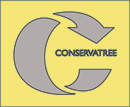
Vol. VI, No. 1, February-April 2007
- Planning for a Flu Epidemic in Child Care
- Children and Nature Network
- Building a Center... Remodeling... Interested in the Environment?
- Using the Right Paper Throughout the Center
- Scotland's First Nature Kindergarten
- National Playground Safety Week, April 21-25, 2007
- Berlin Study Tour to Look at European Outdoor Design
- Need Money for Your Program?
- Spartanburg First Steps Program Invests in Improving Outdoor Environments
- What Are You Doing for Earth Day, April 22, 2007?
- Upcoming Presentations
- Recent Projects
Using the Right Paper Throughout the Center
You can safeguard the sensitive skin of children in your facility and help the environment at the same time by choosing recycled-content paper products like napkins, tissues, toilet paper and paper towels. Find out what to look for on product labels to ensure you're getting a "green" product.
 Spills and messes are a fact of life in childcare centers, but you don't
have to compound the problem by cleaning them up with chlorine-bleached
paper towels made from virgin pulp. While recycled paper has taken hold
in the office, it's also widely available to cover all your kitchen
and classroom uses. Whether you're plying children with tissues
after outdoor play or racing to catch an expanding puddle of milk at
lunch, a wide variety of recycled paper towels, napkins, toilet paper
and tissues can be found to fit your needs. This short article will explain
the importance of using recycled paper.
Spills and messes are a fact of life in childcare centers, but you don't
have to compound the problem by cleaning them up with chlorine-bleached
paper towels made from virgin pulp. While recycled paper has taken hold
in the office, it's also widely available to cover all your kitchen
and classroom uses. Whether you're plying children with tissues
after outdoor play or racing to catch an expanding puddle of milk at
lunch, a wide variety of recycled paper towels, napkins, toilet paper
and tissues can be found to fit your needs. This short article will explain
the importance of using recycled paper.
Paper derived from virgin wood pulp carries a double environmental burden. Deforestation and indiscriminate logging damage ecosystems and the man-made environment by increasing erosion, silt and flooding. In processing, companies bleach paper products with chlorine or chlorine derivatives to maintain the white tissue we've all come to expect. These bleaching practices release dioxins, known carcinogens and endocrine disruptors, into the environment. And the chlorine industry itself has been a major source of neurotoxin mercury emissions into the atmosphere.
Tissue products make up a large portion of the paper products industry. Unfortunately, unlike copy and printer paper, recycling tissue paper is not an option; it is used once and thrown away. About 40 percent of trash found in U.S. landfills consists of paper products, according to non-profit Green Seal, a certifier of environmentally sound paper and other green products.
Switching to recycled products takes minimal effort, but can have a large impact on resource consumption. Consider this: the average American uses 50 pounds of tissue paper (toilet paper, paper towels, etc.) a year, according to Conservatree, a non-profit organization seeking to convert paper markets to environmental papers.
The key to shopping for recycled paper products is to pay attention to labels. Beyond the brand names and colorful pictures lie information on recycled content, post-consumer waste content and the method of bleaching used.
Be sure to look for goods that have the highest Post Consumer Waste (PCW) content. The percentage of PCW in a recycled product refers to the amount of pulp derived from paper that was used by consumers and then recycled. This saves trees and promotes the use of recycled paper.
Seek out products labeled Processed Chlorine Free (PCF). This means that no additional chlorine or chlorine derivatives have been used to bleach the final recycled product. I am allergic to chlorine, as may be the case with many children who have sensitive skin, so pay attention to how the paper you buy is processed. Elemental Chlorine Free (ECF) may also appear on labels of recycled products. However, such labels mean a chlorine derivative has been used to bleach the paper. Although ECF reduces emissions compared with chlorine gas, it still contributes dioxins to the environment.
Attend the 2007 Institute on Creating Sustainable Environments for Young Children and we will share with you more resources on where to locate the best green vendors to purchase recycled paper products.
Vol. VI, No. 1, February-April 2007
- Planning for a Flu Epidemic in Child Care
- Children and Nature Network
- Building a Center... Remodeling... Interested in the Environment?
- Using the Right Paper Throughout the Center
- Scotland's First Nature Kindergarten
- National Playground Safety Week, April 21-25, 2007
- Berlin Study Tour to Look at European Outdoor Design
- Need Money for Your Program?
- Spartanburg First Steps Program Invests in Improving Outdoor Environments
- What Are You Doing for Earth Day, April 22, 2007?
- Upcoming Presentations
- Recent Projects

